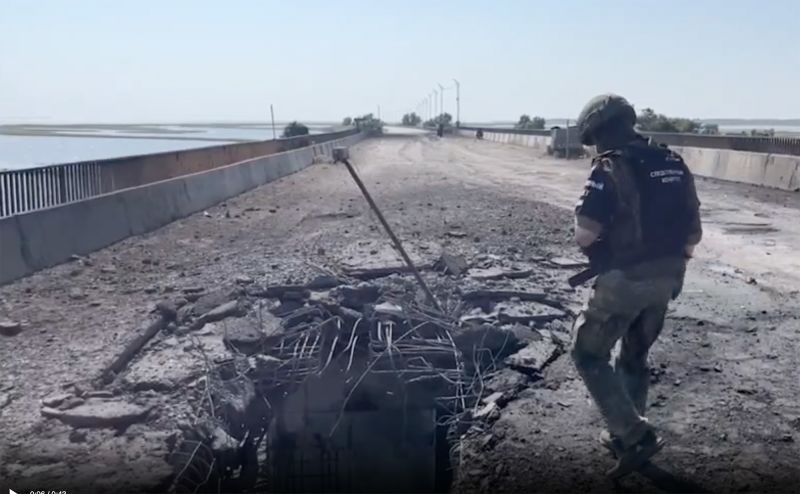
A strike on a Russian-controlled bridge doesn’t change much itself. But it may indicate a more potent strategy
Almost as if to answer Ukrainian President Volodymyr Zelensky’s statement the counteroffensive is “slower” than some might have imagined, a pinpoint strike hit a key pair of bridges for Russia’s occupation. The Chonhar bridges are both rail and road crossings, and head from the northeast of occupied Crimea to Ukraine’s main target in this counteroffensive: occupied Zaporizhzhia region.
Video released from the scene by Russian officials shows a significant hole in the road bridge and apparent damage to the neighbouring rail track, caused, Russian investigators later said, by four missiles. In the video, Vladimir Saldo, the Russian installed governor of occupied Kherson region, walks around the wreckage, and bemoans “another pointless action” assisted, he says, by the London-supplied Storm Shadow missile.
“It won’t decide any results of the special operation”, Saldo adds, before admitting it will make some food and other deliveries a little harder. They will have to use another, longer route, he added, to the West through Armyansk and Perekop, closer to Ukrainian positions.
As a singular event, Saldo is correct to say the one attack decides nothing. But it echoes two earlier events: the damage to the Antonovsky Bridge from Kherson City that eventually presaged Russia’s orderly withdrawal from the right side of the banks of the Dnipro River. And also, less directly, it echoes the damage done last year to the Kerch Strait bridge, which also temporarily disrupted traffic on the only southern supply artery to the peninsula from the Russian mainland. On Sunday, a blast hit what seemed to be a Russian ammunition depot in Rykove, near Chonhar. Blown bridges have a history of impacting both Russian morale and presence.
Alexei Zhivoff, a Russian military blogger, said Thursday the Chonhar bridge was more a “land corridor”, and carried 70% of the military and civilian traffic to and from Crimea. He added the blast showed the area was easily within reach of NATO-supplied missiles and that Russian air defences were inadequate.
It is reasonable to presume these targets have been known to the Ukrainians for some time, and the decision to hit them both in the past week is not an accident. They are likely waiting to impair supply lines to the Russian front lines in Zaporizhzhia at the most damaging time, hoping the sudden loss of supplies, or a panicked bid to restore them, will sap Russian defensive strength at a key moment.
This is in keeping with Ukraine’s tactics in their past two pushes. Both Kherson and Kharkiv – the latter more specifically – relied on hitting the railways that, remarkably in 2023, still form the bulk of Moscow’s rickety – and by now, in this war, legendarily poor – supply chains. Occupying forces fled Kherson when they became cut off. Moscow fled large swathes of Kharkiv, despite it being directly connected to Russia’s borders; they simply could not continue to provide their forces the ammunition and reserves they needed. It will be harder to push Russia into a retreat around Crimea, because of its emotional resonance. But be in no doubt, a peninsula is a tough thing to supply in wartime.
Doubtless, Russia has learned from its significant setbacks. But the strategic accuracy of Ukraine’s strikes on its key infrastructure suggest – amid the slow grind of trench warfare and the incremental seizure of tiny occupied villages – there may be a wider and more potent strategy again at work.
